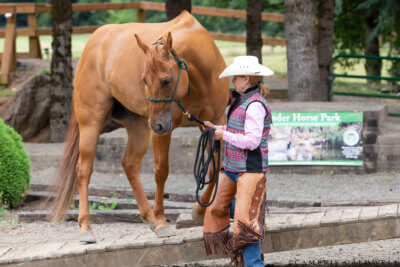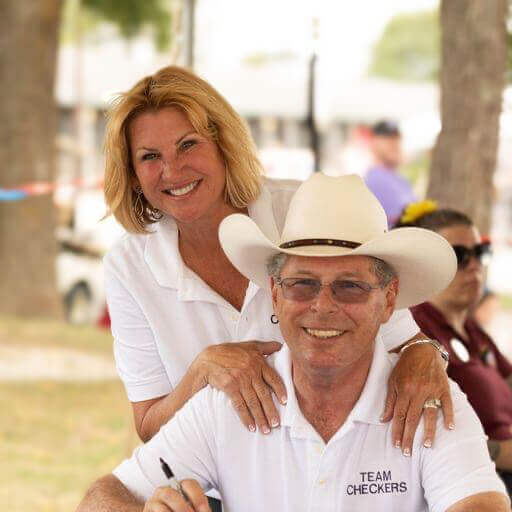The teeter-totter is a very popular obstacle at many trail challenges, and it’s one of the more difficult ones. That’s because most people do not teach their horses how to deal with the ground moving under them. Suddenly, we get to a teeter-totter and we expect them to “just do it.” This would be like taking a 5-year-old and skipping kindergarten through 11th grade and asking them to go straight to 12th. We are setting the horse up to fail at that point. Instead, we should be teaching the horse how to safely navigate the obstacle.
Problem: Horse Jumps on You, Off the Teeter
We always start training an obstacle from the ground first. And no matter the problems you are encountering with the teeter-totter, most of them come down to not having a good enough bubble with your horse. I call this the “Bolender Bubble.” The Bolender Bubble is when your horse has learned to move away from your pressure and not come into your personal space (imagine a circle around you your horse cannot enter). This will keep your horse from jumping off the teeter-totter onto you.
Next, work on your horse stopping when you stop, and backing up when you back. This is great for any trail obstacle. This groundwork is imperative to keep both of you safe as you traverse the obstacles.
Once you have your bubble, you can work on problem solving the teeter-totter.
Problem: Horse Won’t Get On

Start with just asking your horse to put two feet on the end of the teeter-totter that is already down. This is the easiest thing for them to do, especially if your horse already climbs onto boxes. (If not, you may want to start with a non-moving box first). If your horse is still hesitant, you can also try asking him to put his feet up on the side of the teeter, so they would be going across parallel to the center log and not tipping it as the go across. For some horses, this makes it easier.
Don’t rush your horse and don’t get too aggressive. Give them time to think it through. When you get two feet on, turn your horse and walk them off the side, so they don’t tip the teeter. Do this until their head is coming down as they step on. If their head is up, they are in flight mode. Head down is a calming position for your horse, and it is evidence that your horse has mastered that step.
Once you get there, you can ask them to step on with all four feet. And again, have them turn and step off so they don’t tip the teeter just yet. Get them comfortable with this; look for that low headset!
When they will do that, go to the high side and repeat. Sometimes you may need to step on it first, to show the horse what to do. Remember you want to teach them, not make them! We find horses that are taught how to do things remember, even five years later, whereas horses that are forced need constant tuning up. Once you can get all four feet with a nice low headset on the high side, it’s time to walk across. They may rush at first, and that’s okay. You can fix that next!
Problem: Horse Rushes Across
If you have a bubble and your horse knows to stop when you stop, then you can work on this easily. If your horse tries to jump off, go back to working on your bubble. Then all four feet. Stop. Then walk to the middle, stop. Start by asking for two feet on the teeter and then stop. Walk to the edge of the other side and stop. Again, look for the low headset that shows that your horse is calm and thinking instead of in flight mode. Only progress to the next step when that head is low.
Give your horse time to think, learn the obstacle and relax, and you will have a rock-solid teeter-totter in no time!
See this article in the 2020 December online edition:

Mark and Lee Bolender own and operate Bolender Horse Park in Washington State, which houses the finest Mountain Trail course in the world. They are the founders of the International Mountain Trail Challenge Association (IMTCA) and travel worldwide as clinicians and ambassadors of Mountain Trail. Bolender Horse Park offers riders of all skill levels and disciplines a fun and challenging trail riding adventure.
Mark has designed and built Mountain Trail courses in the USA, Canada, Australia, and Europe—with many more in development. Mark uses his artistic, landscaping, horse training, and construction skills to build these courses (NW Steel Design LLC www.nwsteeldesign.com).
Mark is the author of Bolender’s Guide to Mastering Mountain and Extreme Trail Riding. Visit www.bolenderhorsepark.com to learn more.







I really love the extreme trail competion i hope we will have it again soon. I missed out this year.